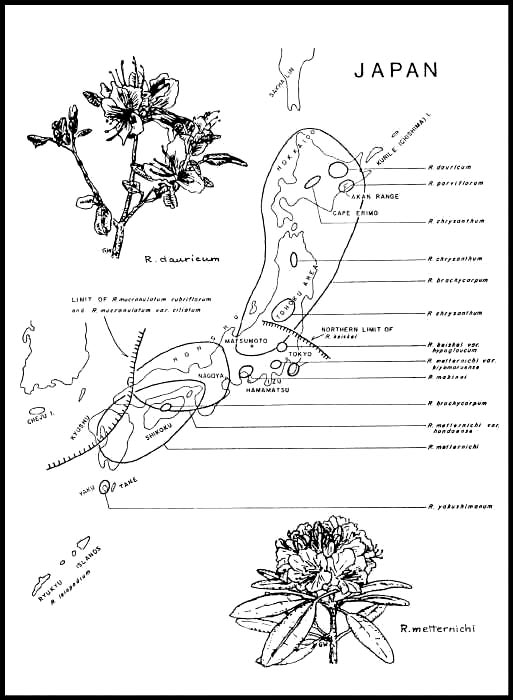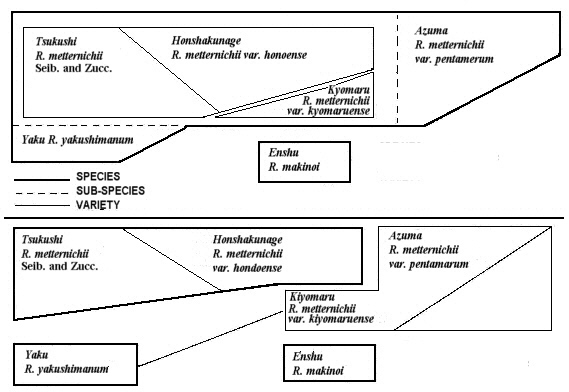QBARS - v32n2 Rhododendrons in Japan
Rhododendrons In Japan
Dr. Richard Pearson
Vancouver, B.C.
In addition to the well-known R. yakushimanum , the Japanese mountains offer a range of interesting species and varieties for growers in the west. These belong to the series Triflorum, Ponticum, and Dauricum. Perhaps the Japanese representatives are segregations of populations which extended from the East Asian continent until the separation of the Japanese islands in the Pleistocene. The range of climate within Japan, and the natural habitat of some species there, suggests that the hardiest ones can be grown in the Toronto-Hamilton area in Ontario; in fact, Hancock Nurseries near Toronto used to grow R. metternichii . Others, however, from the Ryukyu Islands, require greenhouse conditions even in Vancouver.
Renewed interest in rhododendrons in Japan is reflected in the sales of rooted cuttings of natives in the large department stores, and also in two recent publications, Shakunage to Tsutsuji (Rhododendrons and Azaleas) published in 1973 by the Tokyo Sansokai (with 7 printings in 3 months) and Shakunage, sono Shurui to Saibai (The Species and Cultivation of Rhododendrons) published in 1975 by Garden Life. In addition, the revised edition of Makino Tomitaro"s "New Illustrated Flora of Japan (1974) contains some 30 species of rhododendrons and azaleas. From the first two books I have translated and tabulated the sections on native rhododendrons, giving the Japanese names, locations, and characteristics of the plants.
It is stated that rhododendrons were first cultivated in the fiefdom of Satsuma on the southern island of Kyushu as early as 1657 A.D., and that they soon became popular in Osaka and Tokyo. The Chinese characters used for rhododendrons in Japanese actually refer to Photinia serrulata in Chinese, an interesting case of the transfer of a common name to a different plant in the spread from one language to another.
Following is a brief list of species and varieties from the above first two publications. Of particular interest to me has been the close relationship of one large group of species or subspecies, because they seem to show a continual gradient of forms, especially in the young plants. One can imagine a continuous population in past geological times with cooler and wetter environment in Japan. This was subsequently segregated into smaller breeding populations in the upper slopes of certain mountain ranges. These populations seem to have given rise to the species, metternichii , yakushimanum , and makinoi , and their many forms.
Two different schemes for grouping these species show the difficulties in making clear cut distinctions between them (Fig. 1). It would seem that the three together, giving a wide range of indumentum, and luster recurving of the leaves, would be interesting to plant together. Cox has mentioned the superlative qualities of R. keiskei (1973: 179-180) which is known in a wide variety of forms from dwarfs to very large shrubs.
In future, it would be of great interest to explore the Japanese literature on azaleas; this is a much more formidable task since the writings are voluminous and the terminology endless.

|
| Latin Name | Japanese Name | Name in Cox (1973) | Range | Habitat, Remarks |
| Triflorum Series | ||||
| 1. R. keiskei | Hikage shakunage | R. keiskei | From Matsumoto in Shinshu, Kanto Plain, south into Kyushu; endemic to Japan | Yellow flowers, color variable year to year, Kanto forms have thin leaves, compared to those from Kyushu. Honshu forms-upper part of outer bud has reddish brown spots, which remain after the flowers open. These are rare in Kyushu forms. Like shade of rocky cliffs. |
| R. keiskei var procumbens | Haihikage shakunage | Kyushu, Yakushima | ||
| R. keiskei florepleno | Aoba Hikage shakunage | Nagoya, Hamamatsu area, Mikawa area | Double flowers. From fall to winter, leaves develop a yellow stripe, which persists to time of blooming. | |
| R. keiskei var hypoglaucum | Urajiro hikage shakunage | Found in one part of Kanto | New growth is attractive red colour. | |
| R. keiskei var cordifolia | Yakushima hikage shakunage | Yakushima | Long narrow leaves, better form. | |
| R. leiopodum Hayato | Seishika | |||
| R. amamiense Ohwi | Amami seishika | Ryukyu Islands | See Makino, Flowers light purple. Both included under R. leiopodum. | |
| Latin Name | Japanese Name | Name in Cox (1973) | Range | Habitat, Remarks |
| Dauricum Series | ||||
| 2. R. dauricum Linn | Ezomurasaki shakunage | R. dauricum | Hokkaido, North China, eastern Siberia, Korea | Forms grown overseas seem to be derived from Manchurian forms. |
| R. dauricum var sempervirens | Selected evergreen form, retains leaves in winter. Flowers are smaller and stronger in color than Hokkaido forms. | |||
| R. dauricum var albiflorum | Shirobana murasaki shakunage | White flowered form found in several localities in Hokkaido. | ||
| R. dauricum var nana | Hime ezo murasaki Tsutsuji | one location, Nishibetsu near Nemuro City | Slow growing, leaves, flowers are about ½ size compared to other forms. | |
| R. dauricum var nana | Himeji murasaki shakunage | found in one location in Akan Mountain Range, Hokkaido | Reaches only about 8 cm as potted specimen, in 6 years. | |
| 3. R. mucronulatum | R. mucronulatum | from central Honshu to North Kyushu | Shades of purple, leaves turn red in autumn. | |
| R. mucronulatum rubriflorum | Benibana kara murasaki shakunage | red flowered variety found in Western Japan by Ichiro Enomoto | Flowers red, fall foliage also good | |
| R. mucronulatum var ciliatum | Genkai shakunage | Best flower producer. | Leaves are large but drop in fall without much colour. | |
| R. mucronulatum var acuminatum | Uzuki genkai shakunage | thought to be from China, well-known in Korea as Chindarallai | Fall colour not so good, very early flowering, before leaves. | |
| Tannagenkai shakunage | Cheju Island | |||
| Sakuragenkai shakunage | Foreign origin | Clear pink colour, found in western gardens, flowers are small, leaves turn good yellow in fall. | ||
| Lapponicum Series | ||||
| 4. R. parvifolium | Sakai shakunage | R. parvifolium | Sakhalin, Korea, eastern Siberia, Hokkaido | Flowers are a strong purple, in small heads. White flowered forms are also known. Difficult to grow in the Tokyo area. Cox says it blooms in mid-February (1973: 117, 118). |
| Ponticum Series | ||||
| 5. R. brachycarpum | Hakusan shakunage | R. brachycarpum | in high mountains from Hokkaido to mid Honshu, in association with Pinus pumila, can also be found in deciduous forests | Flowers pink, pale cream, can have band of colour down outside of petals. Leaves roundish wide, no hairs, edges of leaves recurved. |
| R. brachycarpum var roseum Koidz | Ezo shakunage | R. fauriei | seems to be most abundant in Hokkaido. Also found in Tohoku but lacking hairs on leaves | Flowers rose in colour. Better not grown in strong western sun with same flower colour May be 2-3 years in pots before setting out. |
| R. brachycarpum var nemotoanum Makino | Nemoto shakunage | found on Mt. Azuma, Mt. Ada Tara in Taroyama in Tohoku, also known from other localities. | Double petals and stamens. Some flowers may be double while others are imperfect. | |
| 6. R. metternichii Seib. and Zucc. | Tsukushi shakunage | R. metternichii | from middle of Honshu to the west-Shikoku and Kyushu | Largest flowers of Japanese rhododendrons. 6-8 lobes, flowers may be double while flatter, new leaves covered in reddish indumentum which sheds from upper surface in rain. Great variation in indumentum; best form with heavy indumentum is called Mimata shakunage. |
| R. metternichii forma albiflorum | Shirobana tsukushi shakunage | Rare in cultivation and in the wild; relatively strong, could be appropriate as a white flowering plant in western Japan. | ||
| R. metternichii forma variegatum | Huiri tsukushi shakunage | cultivated form | Variegated leaves. | |
| R. metternichii var hondoense | Honshakunage, also called mori shakunage oki shakunage | Kinki, Chugoku, Shioku, Kyushu | 5-7 flat petals (lobes) various shades of pink to white, young leaves reddish, hair is thick on underside. | |
| R. mettenichii hondoense var leucanthum | White-flowered, One variety called Muranoshiro, cultivated by Mr. Murano in Nagoya. | |||
| R. metternichii var kiyomaruense Yamazaki | Kiyomaru shakunage | Found in Izu area, northern part of Enshu, Nagoya area | Large leaves, scarce indumentum, flowers have five lobes, colour is very pale. | |
| R. metternichii var kiyomaruense f. leucanthum | Shirobana kiyomaru shakunage | from Amagi Mt. Range | White flowers. | |
| R. metternichii var pentamerum Maxim | Azuma shakunage | R. degronianum | from Kanto to Chubu areas to the north | Many local varieties, most prolific bloomer of Japanese rhodos, occasional bloom in fall. One form with deep divisions between the lobes. Indumentum falls off earlier than yakushimanum . |
| R. metternichii var pentamerum forma leucanthum | Shirobana azuma shakunage | Tohoku | Very pure, clean white. Foliage and form make it the best white. | |
| R. metternichii var yenta-merum forma variegatum | Huiri azuma shakunage | Slow growing, flowers pale, attractive. | ||
| R. metternichii var yakushimum | Yakushima shakunage | R. yakushimanum |
Yakushima,
4000-6000 feet |
Pink, white, leaves recurved, indumentum. |
| Usuge shakunage | lower elevations of Yakushima | Looks very much like metternichi hondoense but seems to breed true. Distinct from yakushimanum , separate clone. | ||
|
Ponticum Series
Caucasicum Subseries |
||||
| 7. R. makinoi | Honba shakunage | R. makinoi ( R. metternichii var angustifolium ) | center of dist. is Horaiji Mt. area, also Enshu area | Leaves are long and narrow, recurved. Ridge along the main vein. Indumentum seems similar yakushimanum . Flowers large, colour good, should be grown in considerable light to show characteristics |
| 8. R. aureum George | Kibane shakunage | R. chrysanthum | Honshu-north, central, and southern Alps, also Hokkaido, Korea, Chishima, Sakhalin, Kamchatka, Korea | Leaves are pale green, blooms early with yellow flowers. |
| R. aureum var niko montanum | Nikko kibane shakunage | R. chrysanthum var niko montanum | Nikko area | Taller, more erect, free flowering according to Cox (1973: 151). He says that Japanese consider it to be natural hybrid of R. chrysanthum with brachycarpum or fauriei ; difficult to distinguish from chrysanthum with juvenile plants. |

|
|
Fig. 1: The relationship of
R. metternichii
,
R. yakushimanum
and
R. makinoi
From Hotta, M. 1974, History and Geography of Plants , p. 294 |
References Cited:
Cox, Peter A., 1973, Dwarf Rhododendrons, New York, MacMillan Co.
Garden Life, Editors, 1975, Shakunage sono Shurui to Saibai, (The Species and Cultivation of Rhododendrons), Seibundo Shinkosha, Tokyo.
Hotta, Mitsuru, 1974, History and Georgraphy of Plants, Evolutionary Biology in Plants, III, Sanseido Co., Ltd.
Makino, Tomitaro, 1974, New Illustrated Flora of Japan, Tokyo, Hokuryukan Ltd.
Tokyo Sansokai, Editors, Shakunage to Tsutsuji, (Rhododendrons and Azaleas) Seibundo Shinkosha.
Acknowledgement:
The map and chart were drawn by Moira Irvine, to whom I wish to offer special thanks.
Reprinted with permission from the Monthly Bulletin of the Alpine Garden Club of British Columbia.
